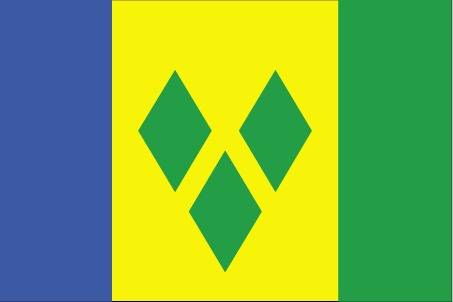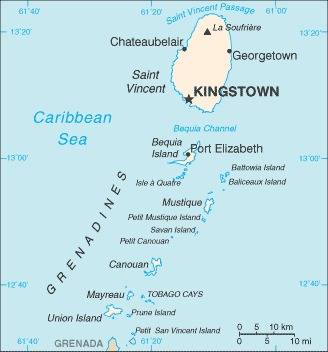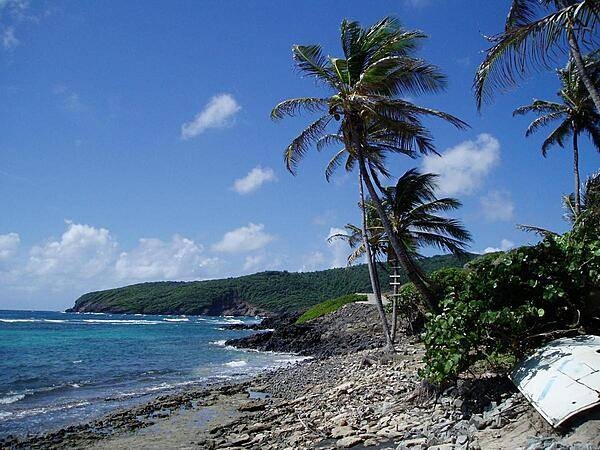32 St. Vincent and Grenadines

Three vertical bands of blue (hoist side), gold (double width), and green. The gold band bears three green diamonds arranged in a V pattern, which stands for Vincent. The diamonds recall the islands as “the Gems of the Antilles” and are set slightly lowered in the gold band to reflect the nation’s position in the Antilles. Blue conveys the colors of a tropical sky and crystal waters, yellow signifies the golden Grenadine sands, and green represents lush vegetation.
Flag courtesy of the CIA World Factbook

Map courtesy of CIA World Factbook

The beach of Bequia, one of the larger islands of the Grenadines of St. Vincent. The object at the lower right is space junk, a piece of a European rocket booster that washed up on the beach.
Photo courtesy of the CIA World Factbook
Government
According to Britannica, Saint Vincent and the Grenadines is a constitutional monarchy with a parliamentary form of government. The British monarch is the head of state and is represented by an appointed governor-general. A prime minister, the leader of the majority party, is the head of government. The unicameral legislature is the House of Assembly. It is composed of 15 members (called representatives) elected to five-year terms by universal adult suffrage, along with six non elected members (called senators) who are appointed by the governor-general—four on the advice of the prime minister and two on the advice of the leader of the opposition. Two additional seats in the legislature are designated for the attorney general and the speaker. The number of members of the House of Assembly may vary between 21 and 23, depending on whether the attorney general and the speaker are elected from inside or outside the House.
Saint Vincent and the Grenadines’ court system consists of a lower and an upper judiciary. The lower courts include magistrates’ and family courts; the High Court and the Court of Appeal form the upper level. Saint Vincent retains its connection with the Eastern Caribbean Supreme Court. This consists of an appeals court and a high court, while the final court of appeal remains the Judicial Committee of the Privy Council in London.
Organization of Eastern Caribbean States (OECS)
The Organization of Eastern Caribbean States (OECS) is an eleven-member grouping of islands spread across the Eastern Caribbean. Together, they form a near-continuous archipelago across the eastern reaches of the Caribbean Sea. They comprise the Leeward Islands: Antigua and Barbuda, Saint Kitts and Nevis, Montserrat, Anguilla and the British Virgin Islands; and the Windward Islands: Dominica, Saint Lucia, Saint Vincent and the Grenadines and Grenada, Martinique and Guadeloupe.
Eastern Caribbean Civil Aviation Authority (ECCAA)
The Eastern Caribbean Civil Aviation Authority (ECCAA) evolved from the Directorate of Civil Aviation – Eastern Caribbean States, which may be considered as one of the oldest, if not the oldest institutions in the Eastern Caribbean region. From inception, the Directorate was seen as a vehicle for facilitating a collective and uniform approach to Civil Aviation matters affecting the then Windward and Leeward Islands, which now comprise the OECS Group.
Airspace
SkyVector – Google Maps – ADS-B Exchange
ICAO countries publish an Aeronautical Information Publication (AIP). This document is divided into three parts: General (GEN), En Route (ENR) and Aerodromes (AD). ENR 1.4 details the types of airspace classes they chose to adopt from classes A through G.
Eastern Caribbean eAIP (requires user name and. password)
Drone Regulations
General Regulations – defines unmanned aircraft
Advanced Air Mobility (AAM) Regulations & Policies
None found by the author.
However, should you, the reader, happen to stumble across something to the contrary, please email the author at FISHE5CA@erau.edu and you may be mentioned in the ACKNOWLEDGEMENTS section of this book by way of thanks for contributing to this free eBook!
Advanced Air Mobility (AAM) News
None found by the author.
However, should you, the reader, happen to stumble across something to the contrary, please email the author at FISHE5CA@erau.edu and you may be mentioned in the ACKNOWLEDGEMENTS section of this book by way of thanks for contributing to this free eBook!
Short Essay Questions
Scenario-Based Question
You have been hired by a Drone Startup Company. Your boss has immediately assigned this job to you.
They need you to prepare a one-page memo detailing the legalities of using a drone at Bequia, pictured above.
They need you to mention any national laws and local ordinances.
They specifically want to know what airspace (insert pictures) you will be operating in and whether or not you need an airspace authorization.
Does it matter whether or not you are a citizen of the country?
Lastly, there is a bonus for you if, as you scroll through this chapter, you find any typos or broken links!
Short Essay Questions
- What are the drone categories?
- How is registration addressed?
- How is remote ID addressed?
- What are the model aircraft rules?
- What are the commercial drone rules?
- Are there waivers or exemptions to the rules? If so, for what?
- Would you share a link to an interactive airspace map?
- How is BVLOS addressed?
- How can you fly drones at night?
- How can you fly drones over people?
- Where do you find drone NOTAMs?
- What are the rules for drone maintenance?
- What are the rules for an SMS program?
- What are some unique rules not mentioned above?
- What are the C-UAS rules?
- What are the AAM rules?

